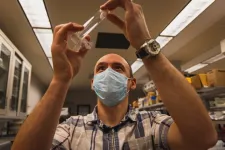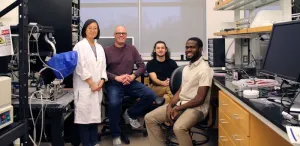(Press-News.org) DURHAM, N.C. – In 787 communities served by the United States’ largest utilities, 17 percent of households struggle to afford basic water services, according to a new analysis by researchers at Duke University.
Nearly half the U.S. population lives in the communities covered by the analysis, which was published May 10 in the open-access journal PLOS Water. The analysis shows that 28.3 million people in those communities live in households that spend more than one day each month working to pay for water services and sanitation services.
“Safe, reliable water services are essential for everyone to thrive, but a substantial number of Americans may be finding them difficult to afford,” said lead author Lauren Patterson, senior fellow at Duke’s Nicholas Institute for Energy, Environment & Sustainability. “When costs rise faster than incomes, it strains the budgets of a wide swath of U.S. households already struggling to make ends meet, as well as utilities trying to adequately serve their customers.”
Utilities in the United States receive limited federal or state investment to cover the costs of infrastructure, treatment, operations and maintenance. Instead, they largely rely on fees charged to households and businesses that access their services. While costs have steadily risen for utilities over decades, their customer bases have seen a widening gap between higher- and lower-income households.
Over nearly two years starting in 2020, the Aspen Institute and the Water Policy Program at Duke’s Nicholas Institute convened a series of discussions with U.S. water leaders to address the economic, environmental and equity concerns around water affordability. A smaller roundtable group met in late 2021 and early 2022 to develop principles and recommendations to help make water services reasonably accessible for everyone while keeping utilities solvent.
One of the key findings of the roundtable is that “the affordability challenge is inadequately defined and measured.” The Duke research team set out to address that with the PLOS Water study.
For their analysis, the authors assumed 6,000 gallons of water per month would be enough to meet the basic water needs of an average U.S. household. Water services were defined as affordable if they cost less than 4.6 percent of monthly income, equal to a day’s worth of labor at minimum wage.
The study focused primarily on utility systems that serve more than 100,000 people. When the authors repeated the analysis for systems with fewer than 10,000 people, they found the average customer paid even more each month compared to larger systems, and unaffordability was more pervasive.
As the authors also note, the thresholds that they used are subjective. They developed an interactive data visualization tool that enables users to adjust the definitions of water usage (2,000–12,000 gallons per month) and financial burden (1–10 percent of monthly income).
“If anything, our estimates of the breadth of water unaffordability are on the conservative side,” said coauthor Sophia Bryson, a 2022 MEM graduate of the Nicholas School of the Environment who now works as an environmental scientist at LimnoTech. “No matter how strictly we set the parameters, we found households struggling to pay their water bills in every single community in our sample. This is a systemic issue for the water sector that is not limited to a specific region, nor strictly urban or rural communities.”
The study cites myriad factors for the widespread nature of the affordability challenge—including low household incomes, increased regulatory costs, increased energy costs, aging infrastructure, population loss, climate change, and the rising costs of capital associated with finance.
In discussing the policy implications of their analysis, the authors write that utility customer assistance programs and other safety net measures are critical to immediately help households unable to pay their bills. Over the longer term, however, the diverse factors that have led to higher utility costs and income inequality “will require approaches that incorporate finance, governance, equity and span from the local to the state and federal scale.”
“Congress passed the Safe Drinking Water Act in 1974 after a nationwide survey showed 14 percent of households were getting drinking water that didn’t meet basic public health guidelines,” said coauthor Martin Doyle, director of the Water Policy Program at the Nicholas Institute for Energy, Environment & Sustainability and professor of river science and policy at the Nicholas School of the Environment. “If that was enough to draw nationwide attention to water quality, then perhaps a similar focus on water affordability is warranted now.”
This analysis was funded by a grant from Spring Point Partners through its Delta Water Innovators program.
CITATION: "Affordability of Household Water Services Across the United States," Lauren A. Patterson, Sophia A. Bryson, Martin W. Doyle. PLOS Water, May 10, 2023. DOI: 10.1371/journal.pwat.0000123
END
17 percent of U.S. households face growing water affordability challenge
Two-year effort quantifies water affordability challenge, offers recommended solutions
2023-05-10
ELSE PRESS RELEASES FROM THIS DATE:
Protein nanoparticle vaccine with adjuvant improves immune response against influenza, biomedical sciences researchers find
2023-05-10
ATLANTA—A novel type of protein nanoparticle vaccine formulation containing influenza proteins and adjuvant to boost immune responses has provided complete protection against influenza viral challenges, according to a new study published by researchers in the Institute for Biomedical Sciences at Georgia State University.
The findings published in the journal Small describe a promising influenza vaccine candidate that uses adjuvants, substances that increase immune response to a vaccine, to boost effectiveness against ...
Songs of the oceans raise environmental awareness #ASA184
2023-05-10
CHICAGO, May 10, 2023 – For many people, there are few sounds as relaxing as ocean waves. But the sound of the seas can also convey deeper emotions and raise awareness about pollution.
At the upcoming 184th Meeting of the Acoustical Society of America, Colin Malloy of Ocean Network Canada will present his method to transform ocean data into captivating, solo percussion songs. The talk, “Sonification of ocean data in art-science,” will take place Wednesday, May 10, at 3:25 p.m. in the Indiana/Iowa room. The meeting will run May 8-12 at the Chicago Marriott Downtown Magnificent Mile Hotel.
To construct his compositions, Malloy employs sound from ...
Sleep apnea, lack of deep sleep linked to worse brain health
2023-05-10
EMBARGOED FOR RELEASE UNTIL 4 P.M. ET, WEDNESDAY, MAY 10, 2023
MINNEAPOLIS – People who have sleep apnea and spend less time in deep sleep may be more likely to have brain biomarkers that have been linked to an increased risk of stroke, Alzheimer’s disease and cognitive decline, according to new research published in the May 10, 2023, online issue of Neurology®, the medical journal of the American Academy of Neurology. The study does not prove that these sleep disturbances cause the changes ...
Virginia Tech researchers conduct proof-of-concept study on mosquito’s scent preferences
2023-05-10
Humans smell. Each and every person has a unique body odor.
People have been using commercial products to alter their scent for generations. From soaps to perfumes, people gravitate to floral and fruity smells.
Whether we think these smells are good or bad is of little consequence to mosquitoes, transmitters of diseases that kill hundreds of thousands of people each year. Additionally, mosquitoes rely on plant nectar to get some sugars needed to sustain their metabolism in addition to needing nutrients in the blood to produce eggs.
And humans with nutrients and a floral scent? That’s two strikes.
In spite of these scents being right under humans’ noses, the impact of ...
Older adults are more easily distracted, study reports
2023-05-10
RIVERSIDE, Calif. -- While engaged in a physical task requiring effort, such as driving a car or carrying grocery bags, older adults are more likely than younger adults to be distracted by items irrelevant to the task at hand, a University of California, Riverside, study reports.
The study assessed the interaction between physical exertion and short-term memory performance when distractors were present or absent in younger and older adults.
“Action and cognition, which interact often in daily life, are sensitive to the effects of aging,” said graduate student Lilian Azer, the first author of the research paper published ...
Texas A&M Institute for Advancing Health through Agriculture seeks experts to support study on responsive agriculture
2023-05-10
College Station, Texas (May 10, 2023) – Texas A&M’s Institute for Advancing Health Through Agriculture (IHA) is spearheading a study that focuses on advancing the concept of responsive agriculture and is seeking experts and leaders in the agriculture-food value chain to serve one of its three committees. The committees, along with a recently named Task Force, will help develop a road map to achieve responsive agriculture, an agricultural system and food environment that supports health ...
How does the brain interpret taste?
2023-05-10
NORMAN, OKLA. – Taste is a complex neurological experience that has the potential to provide extensive, and perhaps surprising, information on how the brain makes sense of sensations and the organization of brain pathways. A research project funded by the National Institutes of Health, led by Christian H. Lemon, Ph.D., an associate professor in the Department of Biology in the Dodge Family College of Arts and Sciences, aims to better understand how the brain processes taste and how those neural pathways can evolve.
Taste ...
ACM and CSTA announce 2022-2023 Cutler-Bell student winners
2023-05-10
The Association for Computing Machinery (ACM) and the Computer Science Teachers Association (CSTA) announced four high school students were selected from among a pool of graduating high school seniors throughout the US for the ACM/CSTA Cutler-Bell Prize in High School Computing. Eligible students applied for the award by submitting a project/artifact that engages modern technology and computer science. A panel of judges selected the recipients based on the ingenuity, complexity, relevancy, and originality of their projects.
The Cutler-Bell Prize promotes ...
Abdominal aortic aneurysm: new treatment may reduce size; COVID infection may speed growth
2023-05-10
Research Highlights
Abdominal aortic aneurysm, a weakening and ballooning of the aorta, the largest blood vessel in the body, may result in a life-threatening rupture.
In a small, preliminary study examining a potential treatment to keep small abdominal aortic aneurysms from growing to a dangerous size, intravenous administration of immune-modulating cells resulted in a significant decrease in pro-inflammatory cells, and with higher doses, there was a decrease in aneurysm size.
In a separate small study, people with abdominal aortic aneurysms ...
Detecting neutrinos from nuclear reactors with water
2023-05-10
The Science
Neutrinos are subatomic particles that interact with matter extremely weakly. They are produced in many types of radioactive decays, including in the core of the Sun and in nuclear reactors. Neutrinos are also impossible to block—they easily travel from the core of a nuclear reactor to a detector far away, and even through the Earth itself. Detecting the tiny signals from neutrinos therefore requires huge devices that are extremely sensitive. The SNO+ experiment has just shown that a detector filled with simple water can still detect reactor neutrinos, even though the neutrinos create only tiny signals in the detector.
The ...
LAST 30 PRESS RELEASES:
Innovative techniques enable Italy’s first imaging of individual trapped atoms
KIER successfully develops Korea-made “calibration thermoelectric module” for measuring thermoelectric device performance
Diversifying US Midwest farming for stability and resilience
Emphasizing immigrants’ deservingness shifts attitudes
Japanese eels, climate change, and river temperature
Pusan National University researchers discover faster, smarter heat treatment for lightweight magnesium metals
China’s 2024 Gastroenterology Report: marked progress in endoscopy quality and disease management
Pusan National University researchers uncover scalable method for ultrahigh-resolution quantum dot displays
Researchers use robotics to find potential new antibiotic among hundreds of metal complexes
Gut bacteria changes at the earliest stages of inflammatory bowel disease
Scientists develop new way to “listen in” on the brain’s hidden language
Brain research: “Pulse generators” grow and shrink as memories are formed
For teens, any cannabis use may have impact on emotional health, academic performance
School meals could unlock major gains for human and planetary health
Menopause hormone therapy does not appear to impact dementia risk
Signature patterns of brain activity may help predict recovery from traumatic brain injury
Dresden study uncovers new key mechanism in cancer cells
New species are now being discovered faster than ever before, study suggests
Cannabis-based products show limited short-term benefit for chronic pain, with increased risk of adverse effects
Cannabis products with more THC slightly reduce pain but cause more side effects
Clearing the brain of aging cells could aid epilepsy and reduce seizures
Brain injuries linked with potential risk of suicide, new study finds
New technique lights up where drugs go in the body, cell by cell
New study finds movement of fishing fleets can reveal shifts in marine ecosystems
Embargoed: New evidence points to potential treatment for vascular dementia
Study uncovers disrupted brain balance in alcohol dependence
Working in groups can help Republicans and Democrats agree on controversial content moderation online
Structural findings reveal how distinct GPCR ligands create different levels of activation
Anything-goes “anyons” may be at the root of surprising quantum experiments
UC review: Maximizing workplace opportunity for veterans
[Press-News.org] 17 percent of U.S. households face growing water affordability challengeTwo-year effort quantifies water affordability challenge, offers recommended solutions






